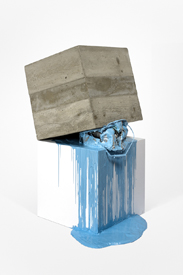
May 23 - July 12, 2012 |
BENJAMIN SABATIER
|
HARD WORK
|
galerie jerome de noirmont
|

Base V, 2012. Concrete, metal paint pot, paint, resin and painted wood.110 x 70 x 75 cm - 43 5/16 x 27 9/16 x 29 1/2 in.
exhibition release
WHERE WORK BECOMES ART
Benjamin Sabatier is one of those artists who addresses the world. Since his performance at the Palais de Tokyo in 2002, his view and artistic practice are part of a socio-economic context where work is seen as the standard model for our contemporary societies. The Chantier exhibition held at the gallery in 2008 already projected us into the world of work and in the making of the art piece itself, with the piece being the place where one feels the weight of time and work.
For his fifth solo exhibition at the gallery from May 23 to July 12, like a disturbing reference to the Ford Company’s slogan "Work Easily, Play Hard", appears this concise and scathing statement: Hard Work. As simple as it is effective, this title does not limit possible interpretations and associations, giving us a perfect illustration of Benjamin Sabatier’s modus operandi.
Beyond the nod to rock music, it is the artist’s creative process that is questioned. All of the 20 installations and sculptures on display are made from raw materials such as concrete, brick or metal in the form of struts, beer cans and barrels; the manufacturing processes are thus very readable. Here Benjamin Sabatier creates an "aesthetics of labor” as a way of reinvesting reality.
Yet if we look closer, the work that the title suggests seems less attributable to the artist than to the materials themselves, as if the artist´s role had been to literally put the raw material to work with simple games of pressure, crushing, spilling... The tool - binding, transforming, distorting - is staged too, in its most simple expression.
In Briques II (2012), the separate elements are assembled by clamps. They then become their own visual elements of the work, all while allowing the sculpture to climb into space. This constructed dynamism is not unlike Tatlin´s constructivism. A kind of "neo-constructivist heroic-ironic" assembly according to art historian Cécile Pichon-Bonin who states that “what Sabatier says lies precisely in this gap which separates the work and its product, updating the central question of the Constructivists about the abolition of the separation between art and work.”
In the Rack series (2009-2010), the sculptures are made from concrete sand bags emptied and then refilled with concrete. They are then dried on brackets and metal racks. Once dried, the sculptures are then removed from their plastic packaging. The bags have now become one with their attachment and suspension system. The concrete retains the imprint of the drying rack and reveals its own weight due to the principle of attraction. Now, we feel a more striking sense of lightness as the bags seem to have turned into cushions.
Sabatier explores the possible limits, functioning with simple and radical oppositions and by reversing power relationships: between heaviness and lightness, strength and fragility. The Cans series (2012) establishes a link between these apparent paradoxes: the cans become the support of a concrete block; a conflict of material that governs the essence of these works.
This dichotomy between the weight of the material and the feeling of lightness is recurrent in these new series. Benjamin Sabatier plays with materials as he plays with the relationship between container and content. With Etai V (2012), the shape of the sculpture is obtained by the pressure of a strut on a paint can. The base becomes the receptacle for what was inside the can. We also see with Etai III (2012), Barrel (2010) and Barrel II (2010) a vertical pressure between floor and ceiling which causes the deformation.
In the Base series (2012), containers (beer cans, paint pots...) are crushed between a concrete block and the base on which they are placed. Their contents are released to become pictorial material and add a visual nature to the work.
Everything is visible and ready for replication. Benjamin Sabatier’s works function almost like prototypes. Each sculpture seems obvious in its design and construction. We find in Hard Work (DIY 914) (2012) an instant read for the viewer which recalls "Do It Yourself", a phrase that is dear to the artist. Hundreds of nails on the wall form the title in counter-relief. A deceptively crude gesture at first glance that appears in negative form like an illusion and that reveals a constructed and thoughtful composition. The work is offered as a kit with the kit becoming the "universal key" that involves the collector in the creative act. Sabatier’s correlation between mass consumption and artistic sphere was displayed by the gallery in 2003 with his first solo exhibition, Peinture en Kit at the Noirmont Prospect, echoing the International Benjamin´s Kit (IBK) developed by the artist since 2001.
Tableau No. 4 (Do It Yourself) (2011-2012) reflects the creative process behind this exhibition and acts as a summary of the different stages of the project. Drawings, simply tacked onto a plywood board, retrace the artist’s train of thought: sketches of works already completed and others which may never be... In continuity with the creative process already shown in the Chantier exhibition, this genuine "wall of inquiry" displays in a clear and legible way the preparatory drawings of Sabatier’s aesthetic proposals, making the ensemble of these "sketches" a visual composition in itself.









